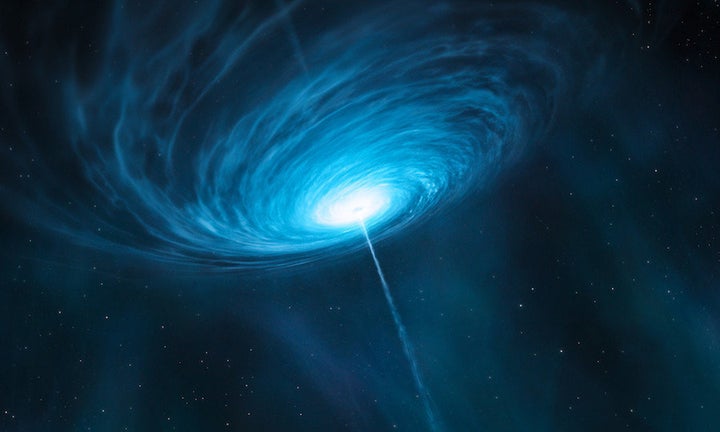
Einstein hated the idea of them. Stephen Hawking has made rather pessimistic wagers about them, and no one has yet seen them up close. Yet despite all of this, the near mythological objects we now call black holes turn out to play a noisy role in making the cosmos appear the way it does.
It makes for a great story; the most extremely peculiar objects in nature at first seem elusive, yet nature's penchant for complex and unexpected arrangements inserts these beasts into the thick of it (and yes, you can conveniently read all of this gripping tale in my new book Gravity's Engines). In 1915 Einstein decreed that gravity is a consequence of the distortion of space around mass. Space is enormously stiff, but not inflexible, and densely concentrated mass scrunches and stretches this malleable not-really-nothingness. A sufficiently dense chunk of matter distorts space enough that even light, the ultimate yardstick, can't emerge without being stretched to invisibility. Thus is born the event horizon, the outer edge of shielding region, the inside of which is forever hidden from the rest of the universe -- a blacker than black hole.
The English seismologist, astronomer, and Reverend John Michell first discussed the possibility of 'dark' bodies in the late 1700s. The idea, maybe because of its outlandish implications, was forgotten. Einstein himself objected to its revival, arguing that if nature formed such places several physical principles would be violated, including the finite speed of light. But as the likes of Robert Oppenheimer pried apart the nuclear world, they gradually saw routes by which the universe could indeed produce these strange things.
We now know that black holes exist. There are numerous small examples dotted around our galaxy. There is also a huge one sitting at the Milky Way's center, causing the orbits of nearby stars to reach absurd speeds of more than 2,000 miles a second -- the means by which tenacious astronomers have measured this hole to be a staggering 4 million times the mass of our Sun. Yet even this is a junior version of what lurks out in the cosmos. Nearly every galaxy seems to play host to a giant hole at its center, and some are as large as 10 or 20 billion times the mass of a normal star.
The science of black holes excels at superlatives, with the simple reason that nothing is ever diminutive about these objects except their girth. The fearsome acceleration and crashing of matter falling to a hole produces tremendous energy well before anything vanishes across the event horizon. It's like the roar of a waterfall, where the energy of motion escapes as sound waves, except on a totally different scale. Since the 1970s we've recognized this signature, spotting enormously luminous cosmic beacons, and violent structures built by the ejection of subatomic particles across hundreds of thousands of light years. Energy production is not always simple. Black holes can also spin and carry electrical charge -- producing a veritable maelstrom of motion outside their horizons. Incoming matter is unable to remain motionless once snared by the rotating fabric of space around a hole. Magnetic fields can channel subatomic detritus up and away in extraordinary jets akin to a natural Large Hadron Collider on mega-steroids, and some of the vast reservoir of energy in the black hole itself is tapped, like a cosmic flywheel.
A well-fed supermassive black hole can easily pump out more than a trillion, trillion, trillion watts of power in light and particle radiation. But this is a temporary situation. In the cosmic past these episodes came and went more frequently, galaxies flaring up for a few million years and then dropping back to relative obscurity. Some have never felt the full-on wrath of their central beasts, others seem to bear the scars in their forms and their stellar components. And this is perhaps the most surprising thing we've learned about black holes. They have played an important, if not critical, role in the growth of galaxies and in determining the total number of stars in these systems, and by extension in the observable universe itself.
The energy put out by hungry black holes stymies the production of new stellar systems by cooking up interstellar and intergalactic matter that would otherwise cool down and condense into suns and planets. It's been doing this since the earliest generations of stars and galaxies some 13 billion years ago. In some cases, deep inside agglomerations of galaxies known as clusters, this energy inflates bubbles within the surrounding intergalactic atmosphere. These bubbles set in motion huge sound waves that gently simmer the cluster, slowing the passage of gas into nebula and baby stars. In other cases a potent mix of ultraviolet and X-ray radiation may similarly hamper or modify the production of new stars. Black holes turn out to be part of a great system of regulation and control.
This property is writ large in a numerical relationship between the mass of supermassive holes and the swarms of central stars in many galaxies. The hole is invariably 1/1000th of the mass of all these suns. Why? We don't really know. There is something in the co-joined history of these giant holes and their host galaxies that makes it so. Intriguingly, our Milky Way does not belong to this club. In fact we live in a galaxy that seems to be in transition, slowly halting its production of new stars. And our central hole is not as quiet as we once thought, with evidence of activity sometime within the past 100,000 years. It may be that the story of our home galaxy and the supermassive hole at its center is still being written. Our presence to witness this is also perhaps not coincidence. The cosmic environment that produced us depends on a complex chain of pathways, one that would be very different closer to one of the universe's most brilliant, yet black, objects.